Carrier (1999) (46 page)
Authors: Tom - Nf Clancy

Along with strike and fighter “muscle,” the air wing includes several support squadrons, which provide specialized services to the battle group.
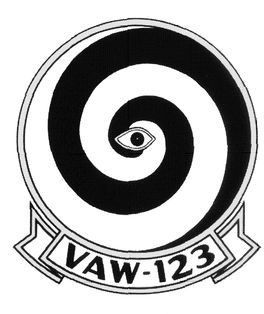
The official emblem of Carrier Airborne Early Warning Squadron (VAW-123), the “Screwtops.”
JACK RYAN ENTERPRISES, LTD., BY LAURA DENINNO
•
Airborne Early Warning Squadron 123 (VAW-123—The “Screwtops”)
—Flying the E-2C Hawkeye, the Screwtops provide the GW battle group with airborne early warning (AEW). Based at NAS Norfolk, Virginia, VAW-123 is one of the Navy’s oldest E-2 squadrons. The squadron’s nickname is reflected in a bold blue and yellow spiral pattern painted on the radome of each aircraft. They are commanded by Lieutenant Commander Edward Rosenquist, and deploy with four late-model E-2C aircraft.
Airborne Early Warning Squadron 123 (VAW-123—The “Screwtops”)
—Flying the E-2C Hawkeye, the Screwtops provide the GW battle group with airborne early warning (AEW). Based at NAS Norfolk, Virginia, VAW-123 is one of the Navy’s oldest E-2 squadrons. The squadron’s nickname is reflected in a bold blue and yellow spiral pattern painted on the radome of each aircraft. They are commanded by Lieutenant Commander Edward Rosenquist, and deploy with four late-model E-2C aircraft.
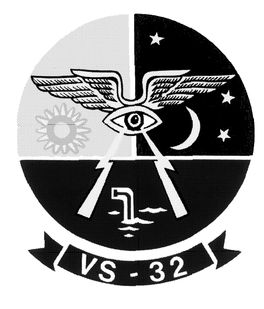
The official emblem of Sea Control Squadron (VS-32), the “Maulers.”
JACK RYAN ENTERPRISES, LTD., BY LAURA DENINNO
•
Sea Control Squadron 32 (VS-32—The “Maulers”)—Of
all the squadrons assigned to CVW-1, none has seen its role changed and enlarged more than the Maulers of VS-32. Flying eight S-3B Vikings, they provide the battle group with surface and ASW services. But their most valuable job is as aerial tankers for the rest of the wing’s thirsty aircraft. Based at NAS Cecil Field, Florida, they are led by Lieutenant Commander John J. Labelle.
Sea Control Squadron 32 (VS-32—The “Maulers”)—Of
all the squadrons assigned to CVW-1, none has seen its role changed and enlarged more than the Maulers of VS-32. Flying eight S-3B Vikings, they provide the battle group with surface and ASW services. But their most valuable job is as aerial tankers for the rest of the wing’s thirsty aircraft. Based at NAS Cecil Field, Florida, they are led by Lieutenant Commander John J. Labelle.
The official emblem of Tactical Electronic Warfare Squadron 137 (VAQ-137), the “Rooks.”
JACK RYAN ENTERPRISES, LTD., BY LAURA DENINNO
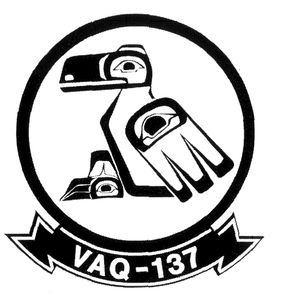
•
Tactical Electronic Warfare Squadron 137 (VAQ-137—The “Rooks”)
—VAQ-137 is tasked with suppressing and jamming enemy radars and communications. The Rooks fly a quartet of EA-6B Prowler aircraft. VAQ-137 is based out of NAS Whidbey Island, Washington, and is commanded by a “retreaded” A-6 Intruder crewman, Commander Craig Geron.
Tactical Electronic Warfare Squadron 137 (VAQ-137—The “Rooks”)
—VAQ-137 is tasked with suppressing and jamming enemy radars and communications. The Rooks fly a quartet of EA-6B Prowler aircraft. VAQ-137 is based out of NAS Whidbey Island, Washington, and is commanded by a “retreaded” A-6 Intruder crewman, Commander Craig Geron.
The official emblem of Helicopter Antisubmarine Squadron II (HS-II) the “Dragon Slayers.”
JACK RYAN ENTERPRISES, LTD., BY LAURA DENINNO
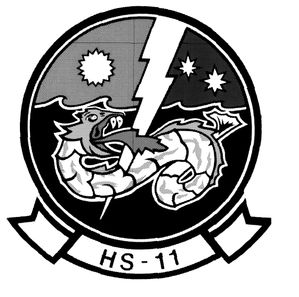
•
Helicopter Antisubmarine Squadron 11 (HS-11—The “Dragon Slayers”)
—The Dragon Slayers of HS-11 are another squadron that has seen its capabilities and responsibilities grow in recent years. In addition to the traditional role of providing the battle group with ASW protection in the “inner” defensive zone, they have taken on new roles of special operations support and search and rescue. They fly four SH-60F (ASW) and two HH-60H (SAR/Special Operations) variants of the Seahawk. HS-11 is based at NAS Jacksonville, Florida, and is led by Commander Michael Mulcahy.
Helicopter Antisubmarine Squadron 11 (HS-11—The “Dragon Slayers”)
—The Dragon Slayers of HS-11 are another squadron that has seen its capabilities and responsibilities grow in recent years. In addition to the traditional role of providing the battle group with ASW protection in the “inner” defensive zone, they have taken on new roles of special operations support and search and rescue. They fly four SH-60F (ASW) and two HH-60H (SAR/Special Operations) variants of the Seahawk. HS-11 is based at NAS Jacksonville, Florida, and is led by Commander Michael Mulcahy.

The official emblem of Fleet Air Reconnaissance Squadron 6 (VQ-6), the “Black Ravens.”
JACK RYAN ENTERPRISES, LTD., BY LAURA DENINNO
•
Fleet Air Reconnaissance Squadron 6, Detachment “C” (VQ-6, Det. C—The “Black Ravens”)
—Flying one of the newest aircraft in Naval aviation, the Black Ravens Detachment “C” provides the battle group with electronic surveillance, intelligence, and targeting. Flying a trio of ES-3 Shadow aircraft, the detachment can, in a pinch, load up with a refueling pod and extra fuel tanks, to provide additional airborne tanking services. The small size of the ES-3 force means that squadron headquarters and schoolhouse remain home-based at NAS Cecil Field, Florida, while small detachments or “Dets” deploy with each CVW. In the fall of 1997, VQ-6 was commanded by Commander Robert “Bob” Wilson, and Det “C” aboard the GW is headed by their Officer-in-Charge (OIC), Lieutenant Commander Terry Isley.
Fleet Air Reconnaissance Squadron 6, Detachment “C” (VQ-6, Det. C—The “Black Ravens”)
—Flying one of the newest aircraft in Naval aviation, the Black Ravens Detachment “C” provides the battle group with electronic surveillance, intelligence, and targeting. Flying a trio of ES-3 Shadow aircraft, the detachment can, in a pinch, load up with a refueling pod and extra fuel tanks, to provide additional airborne tanking services. The small size of the ES-3 force means that squadron headquarters and schoolhouse remain home-based at NAS Cecil Field, Florida, while small detachments or “Dets” deploy with each CVW. In the fall of 1997, VQ-6 was commanded by Commander Robert “Bob” Wilson, and Det “C” aboard the GW is headed by their Officer-in-Charge (OIC), Lieutenant Commander Terry Isley.
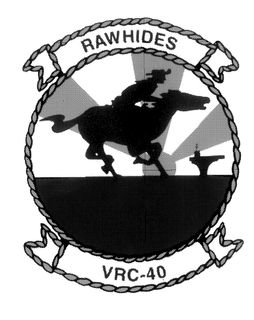
The official emblem of Fleet Logistics Squadron 40 (VRC-40), the “Rawhides.”
JACK RYAN ENTERPRISES, LTD., BY LAURA DENINNO
•
Fleet Logistics Support Squadron 40, Detachment 1 (VRC-40, Det. 1—The “Rawhides”)
—Perhaps the least appreciated task in CVW-1 is the vital task of logistical support. The Rawhides fly a pair of C-2A Trader aircraft for CVW-1 out of their Detachment 1. VRC-40 is based out of NAS Norfolk, VA, and is commanded by Commander Paula Hinger. Lieutenant Commander Steven Faggart led Det. 1 while on cruise.
Fleet Logistics Support Squadron 40, Detachment 1 (VRC-40, Det. 1—The “Rawhides”)
—Perhaps the least appreciated task in CVW-1 is the vital task of logistical support. The Rawhides fly a pair of C-2A Trader aircraft for CVW-1 out of their Detachment 1. VRC-40 is based out of NAS Norfolk, VA, and is commanded by Commander Paula Hinger. Lieutenant Commander Steven Faggart led Det. 1 while on cruise.
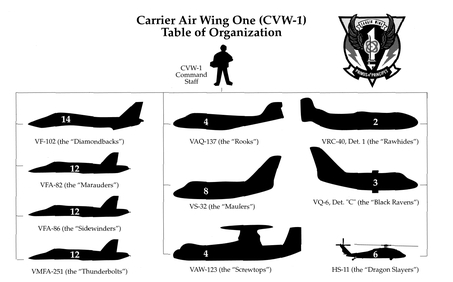
The combat aircraft makeup and organization of Carrier Air Wing One (CVW-I).
JACK RYAN ENTERPRISES, LTD., BY LAURA DENINNO
All of these resources give Captain Stufflebeem a compact and powerful air unit, capable of dishing out impressive amounts of firepower upon targets afloat and ashore. If CVW-1 has a vice, it is the lack of depth in its attached units. With just over seventy aircraft assigned, any loss will be felt in both lost resources and unit morale. Nevertheless, it is a well-structured and balanced force, which can hurt an enemy if properly handled.
Cruiser-Destroyer Group Two: Guarding and Guiding “The Boat”Aircraft carriers and submarines may be the glamorous and expensive superstars of seapower, but the “surface warfare” sailors and their cruisers, destroyers, and frigates are an increasingly visible and vital part of the battle group. These “small” ships (if you can call a ten-thousand-ton cruiser “small”) carry an increasing proportion of the Navy’s usable “in-your-face” combat power. Systems like the Aegis combat system, SM-2 SAM, Tomahawk cruise missile, and SH-60 LAMPS III helicopter are common aboard surface combatants. In the drawn-down Navy of the 1990’s, the Cold War frictions between surface, submarine, and aviation communities have rapidly broken down, making way for a unique kind of “joint” warfare.
To get a view of this synergy, you need to take a look at how today’s CVBGs are organized and commanded. Following Desert Storm and the end of the Cold War, a new arrangement was set up to spread CVBG leadership opportunities more fairly. Previously, each CVBG was controlled by a Carrier Group (CARGRU) headed by a Naval aviator rear admiral. The escorts formed a Cruiser-Destroyer Group (CRUDESGRU), and the two groups to-gether became the battle group. Now, only half the CVBGs are structured this way. The rest (usually three or four at a time) are headed by the CRUDESGRU commander (a rear admiral, lower half, traditionally addressed as “Commodore”), with the carrier and CVW subordinated. Other elements may be attached—the ARG, MEU (SOC), MCM (minesweeping) squadrons, SEAL teams, etc.—and this is the force that deploys for six months at a time.
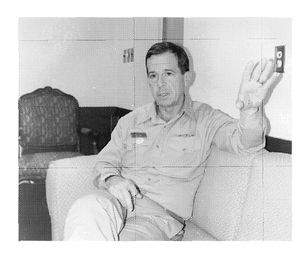
Other books
Deceived and Enslaved by Leo Barton
Safe With You by Sophie Lira
She Likes It Hard by Shane Tyler
Saving Simon (Tarnished Saints Series Book 5) by Elizabeth Rose
Safe Haven by Anna Schmidt
Curfew by Navi' Robins
French Provincial Cooking by Elizabeth David
Psycho by Robert Bloch
The Dark Monk by Oliver Pötzsch, Lee Chadeayne
Claudia Dain by A Kiss To Die For